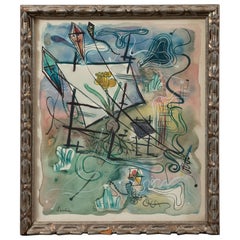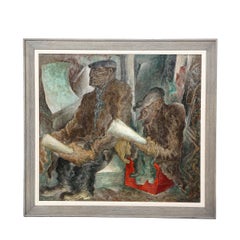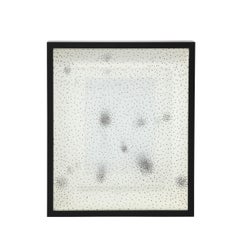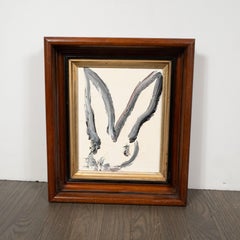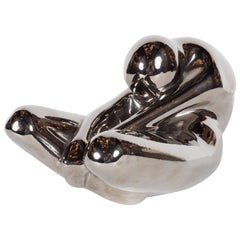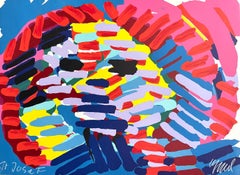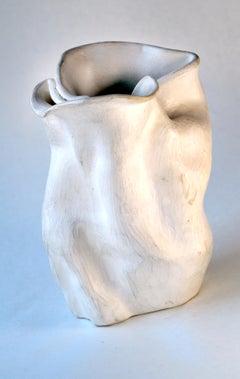High Style Deco Art
Color: Gray
Untitled
Located in New York, NY
This stunning abstract watercolor was realized in the United States circa 1960. The work represents a fantastic hybrid between figurative and abstract painting realized in a style su...
Category
1960s Abstract Abstract Paintings
Materials
Watercolor
WPA Style Scene of Working Men Seated with Newspapers by John Deforest Stull
Located in New York, NY
This beautiful and sophisticated large scale oil on canvas painting was realized by the esteemed American artist John Deforest Stull in 1939. The composition depicts a WPA style scen...
Category
1930s American Modern Figurative Paintings
Materials
Canvas, Oil
Mid Century Modern Dimensional Ink on Acetate Stippled Op Art Mixed Media Work
Located in New York, NY
This refined mid century modern mixed media work was realized in the United States circa 1970. In dialogue with the Op Art movement of the time- popularized by such artists such as V...
Category
1970s Op Art Mixed Media
Materials
Ink
Untitled “From Color to Form” Series
By Marino Marini
Located in New York, NY
This stunning lithograph, was realized by the celebrated Italian artist Marino Marini in 1969. Part of the series “From Color to Form” by Marino Marini (Italian, 1901-1980), this pie...
Category
1960s Abstract Abstract Prints
Materials
Lithograph
Untitled (Bunny Paintiing) ATC691
By Hunt Slonem
Located in New York, NY
This whimsical and sophisticated painting was realized by the esteemed contemporary painter, Hunt Slonem in 2016. It presents a stylized rabbit in profile, rendered with loose and ex...
Category
2010s Neo-Expressionist Animal Paintings
Materials
Canvas, Oil
Modernist Ceramic Platinum-Plated Crouching Man Sculpture by Jaru, circa 1970
By Jaru
Located in New York, NY
This Modernist ceramic sculptures depicts an abstracted and cubist human form sitting cross legged with his back bent forward and arms outstretched. The sculpture, realized by Jaru o...
Category
1970s Abstract Expressionist Figurative Sculptures
Materials
Ceramic
Antique Copper Engraving of an Officer of Pikeman by Francis Grose
By Francis Grose
Located in New York, NY
Francis Grose entered the army early in life and served in the cavalry, infantry, and militia. He produced some compelling and sought after engravings on subjects including ancient a...
Category
19th Century Old Masters Figurative Prints
Materials
Lithograph
Related Items
ONCE I WAS THE SUN Signed Lithograph, Abstract Face, Hot Pink Blue Yellow Red
By Karel Appel
Located in Union City, NJ
ONCE I WAS THE SUN is a limited edition lithograph by the Dutch artist Karel Appel printed using hand lithography techniques on archival printmaking paper, 100% acid free. ONCE I WAS...
Category
1970s Abstract Abstract Prints
Materials
Lithograph
Early 1940s Abstract Pottery Vase #2 after George Ohr
By Hamilton Achille Wolf
Located in Soquel, CA
Wonderful rendition of a "Mad Potter of Biloxi George Ohr" style vase by Hamilton Achille Wolf (American, 1883 - 1967). Size: 6" H x 4" W.
A Post War Cali...
Category
1940s Abstract Expressionist Abstract Sculptures
Materials
Clay, Varnish
H 6 in W 4.5 in D 4 in
"Winter" American Modernism WPA Regionalism Landscape Mid-Century Magic Realism
By Dale Nichols
Located in New York, NY
"Winter" American Modernism WPA Regionalism Landscape Mid-Century Magic Realism. 30 x 40 inches. Oil on canvas, c. 1960s, Signed lower right.
As we list the painting now, the work is currently being cleaned, restored and a hand carved frame is being built. Additional photos will be uploaded as soon as possible.
Our gallery, Helicline Fine Art, just launched our new digital exhibition: American Art: The WPA and Beyond. Three dozen paintings, works on paper and sculptures which are available here on 1stDibs. In person viewings can be arranged by appointment at our midtown Manhattan gallery.
Provenance:
"Winter" was originally purchased by Stanley Byer. Mr. Byer owned homes in Key West, New York City, and Washington, D.C. He purchased the painting from Dunning Auction in 1984 in Elgin, Illinois. Mr. Byer was related to Abraham Weiss from Florida. Saul Babbin, now deceased was a cousin of Mr. Weiss. I purchased the painting from Joy Babbin, Mr. Babbin's wife, now living in from New Mexico.
Dale Nichols (1905 – 1995) Artist, printmaker, illustrator, watercolorist, designer, writer and lecturer, Nichols did paintings that reflected his rural background of Nebraska where he was born in David City, a small town. Although he did much sketching outdoors, most of his paintings were completed in his studio and often included "numerology, magic squares...
Category
1960s American Modern Landscape Paintings
Materials
Oil, Canvas
Jewel coloured vibrant op art abstract geometric painting French 1960s
Located in Norwich, GB
A fabulous example of 1960s geometric/op art, displaying all the fun, playfulness and vibrancy of the style. Op art, short for optical art, is a style of visual art that uses optical illusions. Typically, they give the viewer the impression of movement, hidden images and vibrating patterns. Its roots can be traced back to Cubism, Futurism, Constructivism and Dada.
The maker of this stunning piece is Tony Gonnet (1909-2004) an artist close to those who shaped modern art and its history. Working in Casablanca in 1940 he met André Breton and Saint-Exupéry, who were both on their way to America. Unable to obtain a visa for himself, Gonnet returned to Paris in January of 1942. Living on Rue de Seine, he became one of the figures of Saint-Germain-des-Prés and numbered amongst his many friends Jean-Paul Sartre, Simone de Beauvoir, Jean Genet – who prefaced his first Parisian exhibition in 1952 – as well as Albert Camus, Simone Signoret, Boris Vian, Jacques and Pierre Prévert and many others.
In 1941, in the ennui of Casablanca, Tony Gonnet had started to draw, and then paint, in a Surrealist style. In 1946 he abandoned figurative surrealism in favour of abstraction, making sole use from then on of geometric forms and shaded tones, in his own unique style. His works aim to achieve harmony of shapes and colours, and thus to bring joy. Tony Gonnet loved life, and said that each of his works was an offering made to it.
With solo shows in major Paris galleries...
Category
1960s Op Art Abstract Paintings
Materials
Oil, Board
H 18.12 in W 23.63 in D 1.19 in
Oasis in The Desert, Abstract Geometric Landscape in Green, Blue, Earth Tones
By Natalia Roman
Located in Barcelona, ES
This abstract geometric acrylic painting is a vibrant and playful composition that draws inspiration from vintage Italian parasols. With a focus on bold, bright colors and clean lines, the painting features intersecting shapes and patterns that evoke the cheerful, summery vibe of a day spent lounging in the shade of a colorful umbrella.
Details:
Title: Oasis in The Desert...
Category
2010s Abstract Geometric Abstract Paintings
Materials
Oil Pastel, Oil, Acrylic, Watercolor, Gouache
EVENING WALK Signed Lithograph, Abstract Animal Beige, Yellow, Plum, Blue, Green
By Karel Appel
Located in Union City, NJ
EVENING WALK is an original limited edition lithograph by the Dutch artist Karel Appel printed using hand lithography techniques on Arches paper, 100% acid free. EVENING WALK is a li...
Category
1980s Abstract Abstract Prints
Materials
Lithograph
The Kabbalists, Hassidic Rabbis Judaica Colorful Modernist Painting
By Joseph Wolins
Located in Surfside, FL
Joseph Wolins
1915-1999
Wolins was born in Atlantic City, New Jersey. He studied at the National Academy of Design from 1935 to 1941 under Leon Kroll. He also studied in Europe in ...
Category
20th Century American Modern Figurative Paintings
Materials
Canvas, Oil
“Girl in the Grass”
By Anton Refregier
Located in Southampton, NY
Original oil on canvas painting by Anton Refregier of a young girl resting in the grass. Signed upper right and dated 1962. Condition is very good. The painting is in its original oa...
Category
1960s American Modern Figurative Paintings
Materials
Oil, Canvas
Abstract Procession Jewish Wedding Chuppah Oil Painting Modernist Judaica
By Sabina Teichman
Located in Surfside, FL
Genre: Modern
Subject: Abstract
Medium: Oil
Surface: Canvas
Country: United States
Sabina Teichman: (1905-1983) Studied at Columbia Univ. (BA, MA), also with Charles J. Martin and A...
Category
1950s American Modern Figurative Paintings
Materials
Canvas, Oil
Infestations Vertical 1 : abstract work of art on paper
Located in New York, NY
An artwork on paper by New York artist Miranda Maher. Black archival ink on pale blue archival paper with historical Audubon images of American birds, mo...
Category
2010s Abstract Expressionist Mixed Media
Materials
Paper, Ink, Archival Ink, Archival Paper
The Demogogue
Located in Los Angeles, CA
The Demagogue or Tale in a Tub, 1952, oil on canvas, 20 x 24 inches, signed, titled, and dated verso
About the Painting
The Demagogue is an iconic Bendor Mark painting from the prime of his post-war period. Beginning early in his career, Mark was fascinated with depictions of the human figure and their capacity to tell stories of the world around him. Mark was a keen observer of his times and in The Demagogue we see Mark’s portrayal of a faithless politician holding up a “V” for victory sign as he appeals to the wanton desires and prejudices of the masses. Below the demagogue is a swirl of humanity representing the common man who is being pushed down by the powerful, while the robed figure of liberty with her scales of justice held high is brushed aside. Behind the demagogue, Mark places two other powerful supporting institutions which were often co-opted by the world’s dictators, the Church and the Military. Mark was an internationalist, so it is difficult to know exactly which demagogue inspired him to create this work, but in 1952 there were many to choose from. Whether depicting Argentina’s Peron (the demagogue and the women to the right resemble Juan and Eva Peron), Spain’s Franco or the United States’ homegrown fear mongers like Joseph McCarthy, Mark tells a universal story that unfolded in dramatic fashion during the post-war period as nations and their peoples grappled with authoritarianism and anti-democratic impulses. Stylistically, The Demagogue draws on the elements which make Mark’s work from this period immediately recognizable, a saturated palette, a closely packed and frenetic composition, exaggerated figuration and stylized facial features. But, above all, we see Mark’s ability to tell the stories of the rich and powerful and their ability to oppress. Like Mark’s work in the collection of the Whitney Museum of American Art (The Hourglass - 1950-51) and the Los Angeles County Museum of Art (Execution – 1940), The Demagogue pulls no punches, as the artist lays bare the threats to freedom and basic human rights.
About the Artist
Bendor Mark was an American modernist and social realist painter. Born as Bernard Marcus on June 5, 1912, in Brooklyn, New York, Mark trained at The Cooper Union during the 1920s where he studied with William Brantley van Ingen and became a prize-winning artist with a focus on painting the human figure. After his time at Cooper, Mark continued to live in New York and worked as a commercial artist and textile designer in addition to his pursuit of a career in painting. Like many Depression Era artists, Mark engaged with social progressives and in 1934, he joined the Artist’s Union which had the goal of advancing artists’ position as “worker.” Mark’s painting, Restaurant, which is now in the permanent collection of the Smithsonian American Art Museum, appeared in the February 1936 edition of the Union’s publication, Art Front, as part of a review of an exhibition at ACA Gallery in New York.
Mark worked on the Federal Art Project and by the mid- to late-1930s, began a series of paintings exploring the working conditions and hazards of the mining industry. Mark believed that miners were “in the forefront of the struggle for emancipation” and that the mere “struggle for existence is like moving mountains.” He became passionate about the Spanish Civil War and painted sympathetic images in support of the Spanish Republic. Mark was a premature anti-fascist and throughout his career painted works critical of dictators and other oppressors. During the late 1930s, Mark entered mural competitions with designs influenced by the Mexican muralists, taught adult art education in Queens, New York, and was an instructor at the WPA’s Queensboro Art Center. He was so committed to socially progressive art that by 1934, he had changed his name to Bendor Mark, in part, to distinguish his social realist paintings from his earlier work.
During World War II, Mark worked as an artist for military contractors. After the war, he was employed as a graphic artist and in the printing industry before moving to Southern California in 1948, where he returned to a fine art practice the following year with politically and socially charged images which reflected his view of the shortcomings of the post-War period, the continued threat of fascism, and the international tensions of the Cold War. As the mood of the country shifted towards the right during the McCarthy Era and the art world’s attention focused on abstraction at the expense of figuration, Mark’s career as a painter suffered.
From the 1950s through the 1980s, Mark continued to depict the events that shaped the world around him, often employing a highly stylized approach characterized by dynamic multi-figure compositions, a subtle muted palette, and exaggerated expressive features. A review of Mark’s oeuvre suggests that few people escaped Mark’s attention. He painted presidents, prime ministers, royalty, evangelists, musicians, and dictators (and their henchman), along with miners, farm workers, the urban poor, protesters, the unemployed and dispossessed. He laid bare the arrogance, cruelty, and hypocrisy of the world’s elites. Mark noted, “A work of art cannot be fully appreciated or wholly understood without considering the socio-political and cultural ambience that gave it birth.” He continued, “I have the ability to foresee the direction of social and political events while they are actually taking place.” He was not himself a direct political activist, however. Although Mark commented, “It’s a misconception to separate art from the social aspect of life,” he viewed artists as being neutral. According to Mark, “An apolitical attitude reflects the fact that the artist is passive. . . An artist never affects society; he merely reflects it.”
In addition to the Mexican Muralists, Mark was influenced by the old masters Rembrandt, Michelangelo, and Masaccio, as well as the more modern master, Van Gogh. Mark’s writings directly acknowledge these influences and archival material from his estate includes magazine articles, pamphlets and transparencies related to these artists. Mark also collected materials related to several of his social realist contemporaries, including Reginald Marsh, Ben Shahn, Leonard Baskin, and Raphael Soyer, who was Mark’s good friend. For years, Soyer sent Mark holiday cards and Soyer inscribed a message of friendship on a self-portrait he gifted to Mark in the 1970s, all of which are still held in the collection of Mark’s family.
From the late 1920s through the mid-1950s, Mark’s work was well received. His paintings won prizes and were accepted into major juried exhibitions including at the Brooklyn Museum, the New York World’s Fair and the Metropolitan Museum of Art. He gained national recognition for paintings depicting the oppressed and the common worker. Despite the decline in popularity of representational art during the 1950s and 1960s, Mark stayed true to his interest in depicting the human figure and by the last two decades of his life, his work underwent a reassessment as curators included Mark’s paintings in exhibitions showcasing the role of labor in art during the Depression Era. This recognition continued in recent years when Mark was honored by having his work included in the Whitney Museum of American Art’s ground-breaking exhibition, Vida Americana, which explored the pioneering role that the Mexican muralists played in the development of modern American art during the inter-war period. The influence of Rivera, Siqueiros and Orozco on Mark is unmistakable and his paintings from the 1950s (and beyond) sit comfortably in dialogue with other Los Angeles artists who continued to paint in the social realist tradition long after the mainstream art world had moved toward abstraction. Mark’s concern for underserved Brown and Black communities was shared with artists such as Charles White and his ally, Edward Biberman...
Category
Mid-20th Century American Modern Figurative Paintings
Materials
Canvas, Oil
Yellow River : abstract work of art on paper
Located in New York, NY
An artwork on paper by New York artist Miranda Maher. Ink, Indian marble paper and Chiyogami papers on Chinese “Cicada Wing” calligraphy paper.
Miranda ...
Category
2010s Abstract Mixed Media
Materials
Paper, Ink
